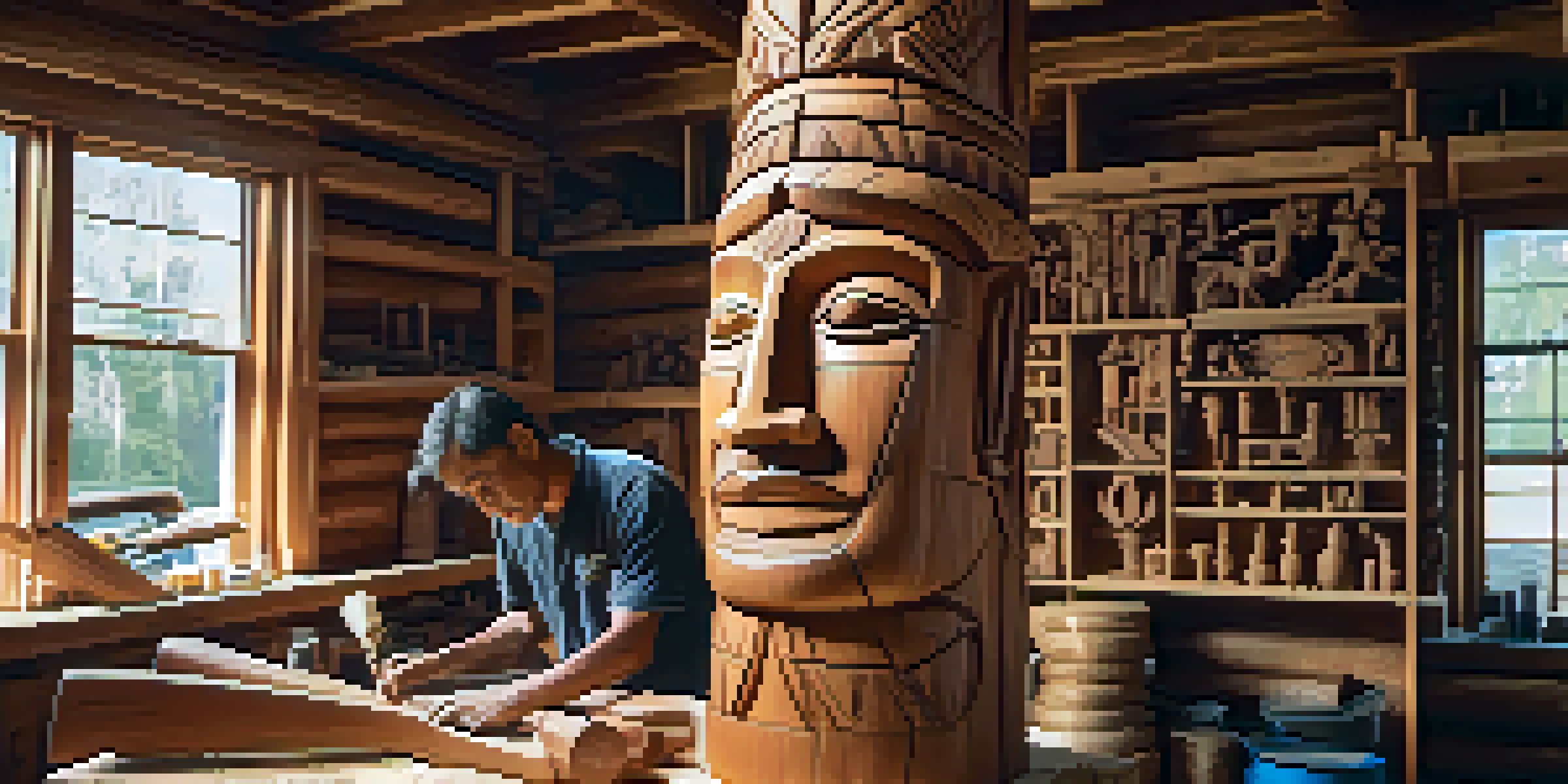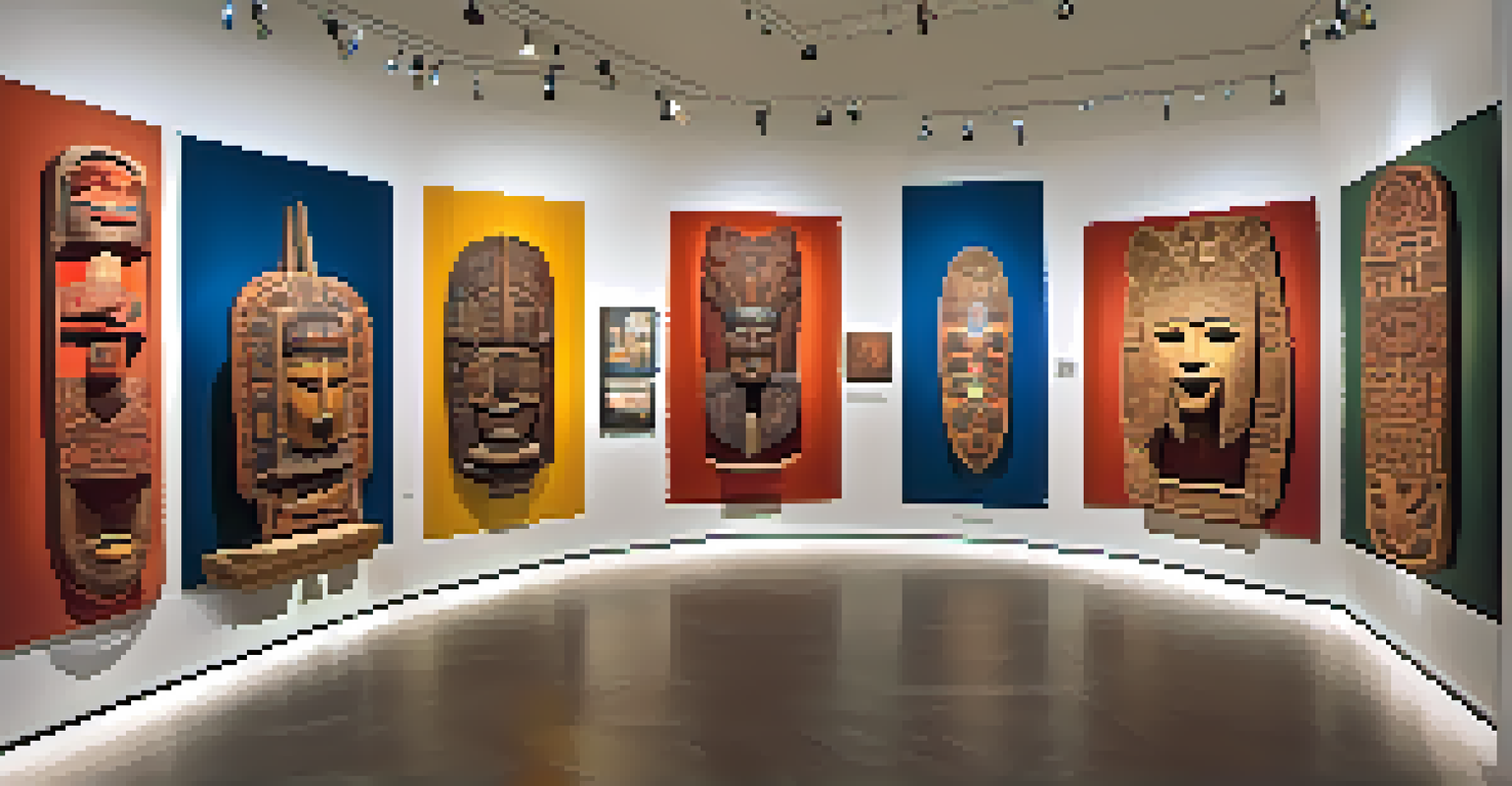The Role of Carving in Indigenous Cultures and Its Impact

Understanding the Historical Context of Carving
Carving has deep roots in Indigenous cultures, often dating back thousands of years. It serves not only as a form of artistic expression but also as a means of storytelling. Each piece carved from wood, stone, or bone carries the weight of history, reflecting the beliefs and traditions of the community.
Art is a way of survival; it's about honoring the past and creating a future.
Traditionally, Indigenous peoples used carving to create tools, ceremonial objects, and decorative art. These items were often imbued with spiritual significance, representing ancestors or natural elements. The techniques and styles of carving varied widely across different regions, showcasing the diversity within Indigenous cultures.
Understanding the historical context of carving helps us appreciate its role beyond mere decoration. Each carved piece is a testament to survival, innovation, and the deep connection between the people and their environment.
The Spiritual Significance of Carving
Many Indigenous cultures see carving as a spiritual practice, linking the creator with their ancestors. This connection is often expressed through the materials chosen; for instance, certain woods are considered sacred. Carvers often seek guidance from the spirits during the creation process, ensuring that their work honors tradition.

Carved items can serve as conduits for spiritual energy, whether they are totems, masks, or ritual objects. These pieces are not just art; they are part of the spiritual landscape of Indigenous life. They embody stories and teachings that are passed down through generations.
Carving Reflects Cultural Heritage
Carving serves as a vital form of artistic expression and storytelling, deeply rooted in Indigenous cultures and traditions.
This spiritual aspect of carving reinforces the idea that art in Indigenous cultures is never just for aesthetics. It is a vital part of cultural identity and continuity, allowing communities to maintain their heritage in a rapidly changing world.
Carving as a Means of Cultural Expression
Carving is a powerful form of cultural expression, allowing Indigenous peoples to convey their unique identities. Through intricate designs and symbols, carvers tell their stories, share their values, and celebrate their heritage. This form of art becomes a visual language that speaks to both community members and outsiders.
Indigenous art is a reflection of our culture, identity, and history, speaking to who we are as a people.
For instance, Pacific Northwest Coast Indigenous groups are renowned for their totem poles, which depict family lineage and significant events. Each carving is meticulously planned, with every detail holding meaning. This not only fosters community pride but also educates others about their rich cultural narratives.
In this way, carving becomes a bridge between past and present, preserving traditions while adapting to contemporary contexts. It's a living art form that evolves, reflecting the ongoing journey of Indigenous peoples.
The Role of Carving in Community Identity
In many Indigenous communities, carving is integral to shaping collective identity. It fosters a sense of belonging and pride, as individuals engage in traditional practices that connect them to their ancestors. Carved objects often become symbols of community resilience and continuity.
Workshops and gatherings centered on carving not only teach skills but also strengthen social bonds. Elders pass down knowledge to younger generations, ensuring that the art form remains vibrant. This intergenerational exchange is crucial for maintaining cultural identity amidst external pressures.
Spiritual Connection in Carving
Many Indigenous cultures view carving as a spiritual practice that links the creator to their ancestors and cultural identity.
As communities embrace carving, they reclaim their narratives and assert their place in the world. This active participation in their cultural heritage reinforces the importance of carving as a tool for empowerment and unity.
Influence of Carving on Contemporary Art
The influence of traditional carving techniques can be seen in contemporary Indigenous art today. Many artists blend modern styles with traditional carving, creating works that resonate with both Indigenous and broader audiences. This fusion allows for a fresh interpretation while honoring ancestral practices.
For example, contemporary carvers might incorporate mixed media, using materials like metal or glass alongside traditional wood. This experimentation not only revitalizes the art form but also challenges perceptions about Indigenous art. It showcases the adaptability and innovation within these cultures.
This dialogue between tradition and modernity encourages a deeper understanding of Indigenous perspectives. It highlights that carving is not a relic of the past but a dynamic practice that continues to evolve.
Challenges Facing Indigenous Carving Practices
Despite its importance, Indigenous carving faces several challenges today. Globalization and commercialization often threaten traditional practices, as mass-produced items flood the market. This can undermine the value of authentic carved pieces, making it harder for artists to earn a living.
Additionally, the loss of traditional knowledge due to colonization has impacted the transmission of carving skills. Many younger members of Indigenous communities may not have access to mentorship or resources necessary to learn these vital techniques. This gap can lead to a decline in the art form's prevalence.
Challenges for Indigenous Carving
Indigenous carving faces challenges from globalization and the loss of traditional knowledge, threatening the preservation of this rich art form.
Addressing these challenges requires concerted efforts from both Indigenous communities and allies. Supporting local artisans and promoting the significance of authentic carving can help preserve this rich cultural heritage for future generations.
Celebrating and Promoting Indigenous Carving
Promoting Indigenous carving goes beyond just appreciation; it involves actively celebrating the art form and its cultural significance. Festivals, exhibitions, and workshops can serve as platforms for showcasing the skills of Indigenous carvers, providing them with recognition and support. These events foster a greater understanding and appreciation of the artistry involved.
Collaborations between Indigenous artists and cultural institutions can also enhance visibility. Such partnerships can educate the public about the stories behind the carvings, making them more than just decorative objects. They become vessels of history and culture, enriching the collective narrative.

By creating spaces for Indigenous voices to be heard and valued, we contribute to the preservation of their carving traditions. This celebration not only honors the past but also inspires future generations to engage with their cultural heritage through art.